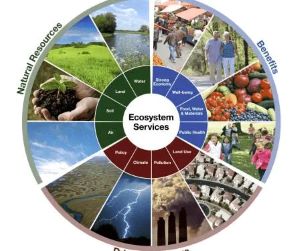Land Use and Biodiversity
By Jeanne Yacoubou, MS
In our recent article on the climate footprints of vegan pizza v. meat pizza, we began by noting two astounding facts about animal agriculture:
- 77% of all soybeans grown in the world is for livestock consumption.
- 74% of the global corn crop is animal feed.
Underlying these statistics is another one of even greater importance concerning land use that we didn’t touch on in our carbon footprints article:
- Livestock takes up 77% of all land suitable for agriculture on the planet. This includes grazing land plus land used to grow the crops they eat.
You may think that if livestock took up more than three quarters of the world’s agricultural land, it would at least produce the most food calories and protein available for human consumption. Unfortunately, this is far from the truth.
For all that land use, raising livestock contributes merely 18% of the world’s calories and only 37% of total protein according to an analysis by Our World in Data based on the work by Poore & Nemecek. This is a very inefficient way to feed over 8 billion people.
By contrast, if everyone in the world were vegan, we could reduce the amount of agricultural land needed to feed people a nutritious diet by 75% concludes that analysis. Since it takes almost 100 times as much land to produce a gram of protein from beef versus tofu, you can see how the land savings would quickly add up when everyone converts to veganism.
However, predicting greater meat consumption with an exploding population of nearly 10 billion by 2050, the World Resources Institute calculates feeding them will require 600 million more hectares of land for grazing and feed crops.
On an already crowded planet, where is this land supposed to come from? Deforestation.
According to the World Resources Institute, rates of primary forest loss are still increasing despite the declaration of 145 countries in 2021 to halt and reverse deforestation by the end of this decade. In 2022, 4.1 million hectares were lost. That’s the equivalent of 11 soccer fields per minute and 2.7 gigatons of carbon emissions.
Along with this habitat loss, continued deforestation plunges the world’s biodiversity further into crisis. Experts refer to the current loss as the sixth mass extinction. Currently, one million species of animals and plants are at risk of extinction in the next few decades.
Forests contain the most species diversity of any ecosystem:
- 60,000 tree species
- 80% of amphibian species
- 75% of bird species
- 68% of mammal species
Ecologists warn that the rapid loss of biodiversity is a death knell for human civilization, even more so than the climate crisis. Although the problems humanity are facing threaten human existence, system change can reverse course.
Ending animal agriculture by switching to veganism will remove the need for more deforestation to supply cropland and grazing areas necessary for livestock. Instead, the restoration of natural ecosystems (rewilding) on unused agricultural land can occur – barring more urban development. And with more intact nature, biodiversity will surely rebound.
Everyone wins in that situation.
To support The Vegetarian Resource Group research, donate at www.vrg.org/donate
Or join at www.vrg.org/member/cabdacae.php

